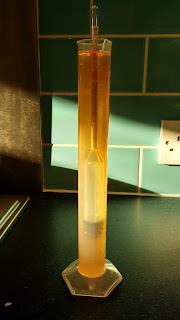My most recent effort brewed 20/10/2016
Not sure what to call this, a black IPA? Hoppy Porter?
Grain Bill:
4kg Maris Otter
200g Chocolate Malt
120g Roasted Barley
80g Carafa III
Hops:
35g Galena 13.2% - at start of boil
20g Citra 13.7% - 15 mins from end
40g Citra 13.7% - at end of boil
25g Amarillo 10.1% - at end of boil
Yeast: Fermentis Safale S04 - 1 pack
The Mash - 60 mins
- Add 29lt water to pan and heat to 70°C. Turn off heat.
- Put bag in pan and add grains slowly. Mix well to avoid clumping.
- Check temperature, should now be 68°C. Add heat if necessary but ensure you do not burn the grain bag! A false bottom in the pan helps to avoid burning.
- Replace lid and leave for 60 mins. Have a beer, walk the dog, etc.
- Carefully lift out bag allowing the hot wort to drain into the pan. I tend to put the grain bag into a fermenter with an upturned colander in the bottom and leave it to drain some more. You can then squeeze the bag to extract as much wort as possible. In this case I ended up with about 27.5lt of wort in the pan.
 |
| Temperature check after grains are added |
The Boil - 60 mins
- Bring the pan of wort up to boiling and add the first hop addition, cover and leave to boil.
- After 45 mins add the next batch of hops. I also put my immersion chiller into the pan and bring back to the boil, this will sterilise the chiller. Boil for a further 15 mins and turn off heat.
- Add final quantities of hops and leave to cool for 10-15 mins.
- Connect immersion chiller to cold tap and chill the wort down to 20°C as quickly as possible
 |
| Chilling the wort |
Fermentation
- While the wort is cooling I thoroughly sterilise the fermenter, seive, airlock and a plastic jug.
- Once wort is chilled down to 20°C it is ready to be transferred to the fermenter. Using the sterilised plastic jug pour the wort through the seive into the fermenter. I ended up with 21lt in the fermenter.
- Pour some wort into a test jar and take a hydrometer reading. In this case the OG was 1.050 which was exactly what was expected!
- Sprinkle the dried yeast onto the wort and seal the fermenter. Fill the airlock with previously boiled water and fit into the lid.
- Wait! The airlock should bubble away nicely for a few days, I usually leave the fermenter alone for at least 2 weeks before kegging or bottling.








